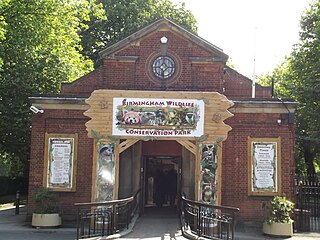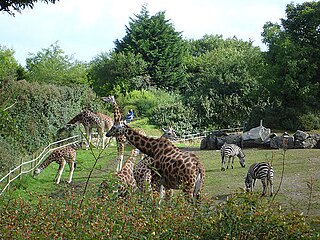
Marwell Zoo is a 140-acre (57 ha) zoo situated in Colden Common near Winchester, in the English county of Hampshire. It is owned and run by the registered charity Marwell Wildlife. The zoo is home to 1,208 animals of 149 species. The charity undertakes a range of educational and conservation activities, with a particular focus on Africa in addition to work from its base.

Chester Zoo is a zoo at Upton-by-Chester, Cheshire, England. Chester Zoo was opened in 1931 by George Mottershead and his family. It is one of the UK's largest zoos at 51 hectares. The zoo has a total land holding of approximately 160 hectares.

Apenheul Primate Park is a zoo in Apeldoorn, Netherlands. It specializes in apes and monkeys. It opened in 1971 and was the first zoo in the world where monkeys could walk around freely in the forest and between the visitors. It started with just a few species, now it displays more than 30 different primates, among them bonobo, gorilla and orangutan.

Colchester Zoo is a zoological garden situated near Colchester, England. The zoo opened in 1963 and celebrated its 50th anniversary on 2 June 2013. It is home to many rare and endangered species, including big cats, primates and birds as well as many invertebrates and fish species.

Birmingham Wildlife Conservation Park, formerly Birmingham Nature Centre, and before that Birmingham Zoo, is a small zoo on the edge of Cannon Hill Park in Birmingham, England. It is owned and managed by Birmingham City Council.

Belfast Zoological Gardens is a zoo in Belfast, Northern Ireland. It is in a relatively secluded location on the northeastern slope of Cavehill, overlooking Belfast's Antrim Road.

Paignton Zoo is a zoo in Paignton, Devon, England. The zoo is part of South West Environmental Parks Ltd which is owned by the charity Wild Planet Trust, formerly known as the Whitley Wildlife Conservation Trust. The charity also runs Newquay Zoo in Newquay, Cornwall, and ran Living Coasts in Torquay, Devon until its closure in 2020.

The American Species Survival Plan or SSP program was developed in 1981 by the (American) Association of Zoos and Aquariums to help ensure the survival of selected species in zoos and aquariums, most of which are threatened or endangered in the wild.

The San Antonio Zoo is an Association of Zoos and Aquariums-accredited zoo in Midtown San Antonio, Texas, United States. It is located in the city's Brackenridge Park. San Antonio Zoo is a 50+ acre zoo home to over 750 species, some of which are endangered or extinct in the wild, and an annual attendance of more than 1 million. It also runs non-animal attractions, such as the 2 ft narrow gauge San Antonio Zoo Eagle train ride, which first opened in 1956 and utilizes three Chance Rides C.P. Huntington locomotives.

Shanghai Zoological Park, or commonly Shanghai Zoo in short, is the main zoological garden in Shanghai. It is located near the township of Hongqiao and is administratively in Changning District. Shanghai Zoo was formerly known as " Xijiao Park", which is still a common name used locally for the zoo.

Newquay Zoo is a zoological garden located within Trenance Leisure Park in Newquay, England. The zoo was opened in Cornwall on Whit Monday, 26 May 1969 by the local council. It was privately owned by Mike Thomas and Roger Martin from 1993 until 2003. In August 2003 Stewart Muir became the new Director and the zoo became part of the Whitley Wildlife Conservation Trust, alongside Paignton Zoo and Living Coasts. The zoo is part of a registered charity, and was awarded various South West and Cornwall 'Visitor Attraction of The Year' and 'Sustainable Tourism' awards for excellence in 2006, 2007 and 2008. Newquay Zoo is now run as part of the Wild Planet Trust, the new name for the Whitley Wildlife Conservation Trust.

Dartmoor Zoological Park is a 30-acre (12 ha) zoo just north of the village of Sparkwell, on the south-west edge of Dartmoor, in the county of Devon in the South West of England. It was opened in 1968 by Ellis Daw who ran it until its licence was revoked and it was forced to close in 2006. The zoo was bought in August 2006 by Benjamin Mee, who reopened the zoo in July 2007, later writing a book about his experiences called We Bought a Zoo (2008). A 2011 film of the same title was loosely based on the book.

Tasmania Zoo is a zoo located in Launceston, in the Australian state of Tasmania. Situated on 900 acres (360 ha) of old growth native bushland, it is home to the state's largest collection of native and exotic animals. Tasmania Zoo is a fully accredited member of the Zoo and Aquarium Association, working closely with all Australasian zoos, and are involved in various species management programs.

The Lakeland Wildlife Oasis is a small zoological collection near the town of Milnthorpe, Cumbria, England, with a science and evolution theme. Since April 2012 the zoo has been run by the registered charity Lakeland Trust for Natural Sciences.

Banham Zoological Gardens is a 50-acre (20 ha) zoo in Banham, Norfolk, England. The zoo itself, which today is home to more than 2,000 animals, opened to the public in 1968, became a charity in 2013, and has since been often awarded the prize of Norfolk's Top Attraction, by numerous different organisations, with an annual visitor attendance of in excess of 200,000 people. It is part of the Zoological Society of East Anglia, a registered charity which also owns Africa Alive Zoological Reserve near Lowestoft, Suffolk.

BestZOO is a small zoo in Best, North Brabant, Netherlands. It opened in 1930 as Vleut the Zoo, and was owned and operated by the van Laarhoven family until purchased by Zodiac Zoos in 2007. Zodiac Zoos upgraded many of the old exhibits to more naturalistic settings, but sold them to Jos Nooren in 2010 before all upgrades were completed.

Barcelona Zoo is a zoo in the Parc de la Ciutadella in Barcelona, Catalonia, Spain. The zoo used to be internationally known as the home of Snowflake, the only known albino gorilla, who died in 2003.

The Yorkshire Wildlife Park is a wildlife conservation and rehabilition centre and tourist attraction located in Branton, south-east of Doncaster, South Yorkshire, England. It opened in 2009 on the site of Brockholes Farm, a former riding school and petting zoo, and features 500 animals of 100 species. Yorkshire Wildlife Park is an official member of the British and Irish Association of Zoos and Aquariums (BIAZA) and the European Association of Zoos and Aquaria (EAZA).

The Folly Farm Adventure Park and Zoo, situated to the north of Saundersfoot and Tenby in Pembrokeshire, is a visitor attraction in Wales with around 500,000 visitors each year. Initially a farm attraction, the park is now also home to an indoor vintage funfair, a zoo with over 200 different species of animal and extensive indoor and outdoor adventure play areas.

Wildlife HQ Zoo, is located at the Big Pineapple, Woombye, Queensland on the Sunshine Coast, Queensland and opened in November 2013. In March 2014 many animals were relocated from the now closed Alma Park Zoo.





















